
Iconography and Photos of Our Church
Icons of Our Parish
In the Orthodox Church, the icon is actually theology in color. It acknowledges the Incarnation of God, that he became man in Jesus. It attempts to portray the two natures of Christ: the human and divine. The icon helps worshippers to concentrate on the high spritual values of the holy people depicted. It is for this reason that the icon does not depict the physical beauty of the saint, but rather the spititual qualities such as sacrifice, humility, devotion, faith and love. It inspires reverence in worship, and provides instruction for the faithful. In the Orthodox tradition, the faithful bestows honor, veneration, and reverence not to the painted wood, but to the person that is depicted because of the holiness and glorification he/she has received by God. Indeed, the faithful experience a spiritual communion with the saints since both churches, the one that exists on earth (the Militant) and the Church of Heaven (the Triumphant) belong to the same body of Christ.
Iconostasis
The Iconostasis crafted out of Botticino marble separates the Nave from the Holy Altar. It is a permanent partition and also serves as the frame supporting the mosaic icons. The Royal Gate with its symbolic representations is for the use of the priest, and the two side doors with the guardian figures of the archangels Michael and Gabriel, are for the deacons and altar boys. In the Old Testament, the temple veil separated the Holy of Holies from the main section of the temple. Only the clergy may enter and exit through the Royal Doors , and only at specified times during the Divine Services. It is through these gates that the Heavenly King enters in the form of the elements that will be consecrated into the body and blood of Christ. It is through these gates that Holy Communion is administered to the faithful. The wheat and the vine are depicted on the Royal Doors. The wheat symbolizes Jesus, the bread of life, and the vine symbolizes the words of Jesus who said. "I am the vine, you are the branches". To the right of the Royal Doors is the icon of Jesus Christ followed by the icon of St John the Baptist. To the left is the icon of the Virgin Mary, the mother of God followed by the icon of Sts. Constantine and Helen, the saints for which this particular church was named. The icons of Archangels Michael and Gabriel are depicted on the side doors. To the right of Archangel Michael are the icons of St. Katherine and St. Theodore. To the left of Archangel Gabriel are the icons of Saints Peter and Paul and St. George.

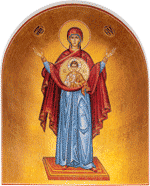
Platytera
The Mother of God (Theotokos, Birth-Giver of God): The place behind the Altar is reserved only for the icon of the Virgin Mary, the Mother of God. This icon is called the Platytera (Broader than the heavens). The Theotokos became the connecting link between the Creator and the creation, between God and man, heaven and earth. She took first place next to her Son in heaven, and from there she continues to pray and intercede for us. As the Queen of Heaven, she is surrounded by divine grace, holiness and purity. On the byzantine icon of the Theotokos, one sees how the expression of the soul is concentrated on the face. The icon expresses the virtue of meekness, humility, purity, spiritual love, and wisdom. In orthodox iconography the Mother of God is always depicted with the infant Jesus.

The Pantokrator
Above the Church on the ceiling of the dome is the largest mosaic in the world of the Pantokrator. Christ the Almighty. This icon portrays the triumphant Christ who reigns as Lord of heaven and earth. Directly below and surrounding this icon are the prophets Elijah, Ezekiel, Isaiah, and Jerimah of the Old Testament, who spoke of His coming. Each are positioned between a Cherubim. At the barrel of the dome under the 16 circular windows is the inscription in both English and original Greek which reads: I am the Light of the World, He that follows me shall not walk in darkness, But shall have the Light of Life
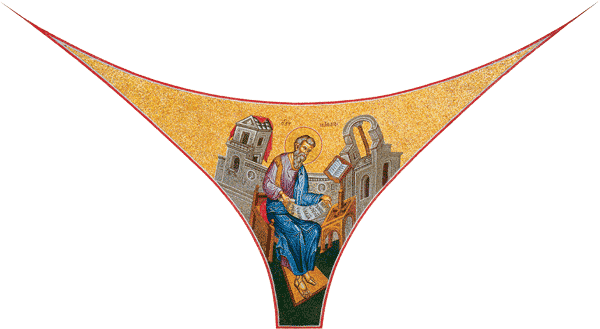

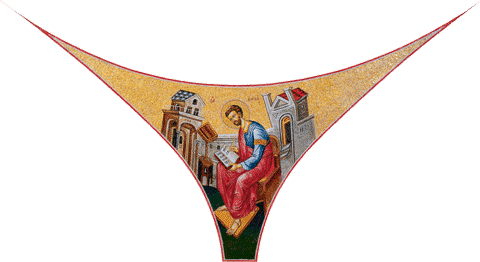

The Four Evangelists
Beneath the dome at the four pendantives, are the four Evangelists, authors of the Gospel, who were inspired by God in the writing of the Bible. Moving clockwise, from the right of the Altar, is Saint John the Theologian dictating to his disciple Prokopios, Saint Matthew, Saint Luke and Saint Mark.

Palm Sunday
Palm Sunday commemorates the entry of Christ on a donkey into Jerusalem, just before the Jewish Passover, which he came to observe with his disciples. The story is told in the Matin Gospel for the day (Matthew 21:1-17). As Jesus entered the city, the people met him with shouts of joy and spread palm branches before him as he rode through the city. They greeted him as a King, come to set the people of Israel free from bondage. The Palm branches they used were an ancient symbol of victory; today they symbolize Christ's triumph over death.

The Crucifixion (on the left as we face the Altar)
The forms and colors do not impart the frigid breath of death, but the sweet hope of immortality. Christ is depicted as standing on the Cross, not hanging on it. His body is of flesh, but flesh of another nature, flesh whose nature has been changed through the grace of the Holy Spirit. The expression on His face is full of heavenly tranquility; the affliction which has befallen Him full of gentleness and forgiveness, exempt from agonized contractions on the face. It is the suffering redeemer. He, Who has undone the pangs of death, Who has granted the peace of the life to come. This crucified body is not that of just anyone, but is the very body of the God-Man Himself.

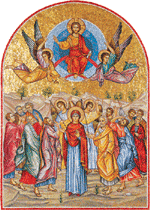


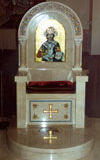
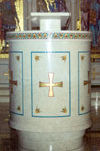

The Resurrection (on the right as you face the Altar)
Christ resurrected from the dead by trampling upon death and destroying the kingdom of death. According to the teachings of the Orthodox Church, Christ descended to Hades during his three day burial, and opened the gates bringing salvation to the righteous people of the Old Testament. In the icon of the resurrection, we see Christ the Lord stepping upon the gates of Hades and pulling Adam and Eave out of the grave. They represent the sinful mankind to whom salvation and bodily resurrection will come through the resurrected Christ.
Ascension Thursday
Ascension Thurday falls on the fortieth day after Easter. After His Resurrrection, the Lord appeared many times to several of His followers, preaching to them, and teaching them concerning Himself. Each of the eleven gospel selections read on successive Sunday mornings during the Orthodox Service of Morning Prayer has as its subject one of the appearances of the risen Loard to his Disciples. After forty days had passed, Christ took leave of His followers in the manner described in the Apostle (Acts 1:1-12) and Gospel (Luke 24:36-53), appointed to be read on the Feast of the Ascension. Then He returned to His Father, leaving His Disciples and Apostles to await the coming of the Holy Spirit on the day of Pentecost
The Holy Altar or Sanctuary
This the most important area of the Orthodox Church. The Divine Services are conducted, and the bloodless sacrifice of the Lord's Body and Blood is offered inside the Holy Altar. Only those who are ordained are permitted to enter the Altar.
The Holy Table. The main part of the Altar is the Holy Table, which represents the Throne of God in Heaven. The Holy Table also represents Golgotha and the tomb of Christ. During the first 300 years of Christianity, when worship was conducted in underground catacombs, the early Christians celebrated the Liturgy over the graves of the martyrs. From this early Christian custom has come the practice of placing holy relics of saints in the Holy Altar at the time of consecration. This symbolizes that the Church was founded upon the blood of martyrs. In our Church, Saints Constantine and Helen. The face on the front of the Holy Table depicts the Last Supper (mosaic inlaid in marble).
Hospitality of Abraham (on the west side wall of the Church)
Three angels sit at a table and are waited upon by Abraham and Sarah. The scene is based on the passage from Genesis 18:1 in which the Lord is reported to have appeared before Abraham in the grove of Mamre, in the form of three men. On the table are radishes, bread, and the head of the lamb prepared by Abraham. The table is a type of altar, with the vessels of the Eucharist upon it. St. Cyril of Alexandria imagined this story to be the revelation of the Trinity to man in the embodiment of the three angelic messengers. To the left is the icon of Moses holding the Tablets of the Law, (the ten commandments). To the right is the icon of Jesus in the Temple teaching the crowds.
The Bishop's Throne
The Bishop's Throne is used by the Bishop or Archbishop during worship services. The Bishop, considered to be the authority of the Church, and the representative of Christ, is symbolically present in every worship service by the icon of Christ, the High Priest, depicted on the throne.
The Pulpit
From the Pulpit, the priest or deacon reads the Holy Gospel during the Divine Liturgy, and the Word of God is preached by the clergy. Depicted here, usually, are the icons of Christ, St. Paul, or the four Evangelists.
The Stained Glass Windows
The Stained Glass Windows are based on early Byzantine symbols and monograms used for centuries in Orthodox religious artwork, complementing both the elaborate mosaic iconography and the relative simplicity of the church.

